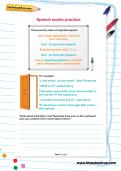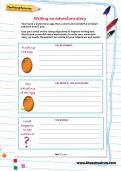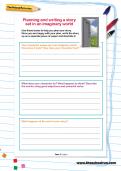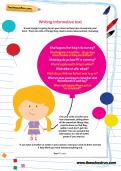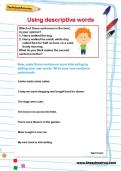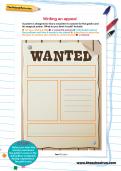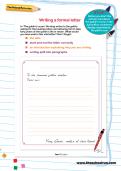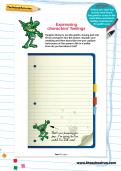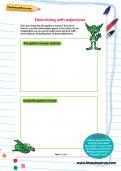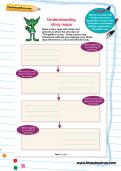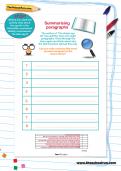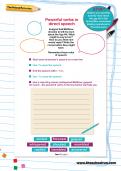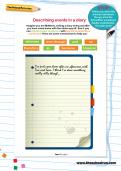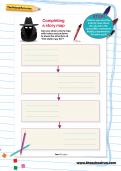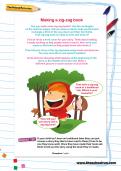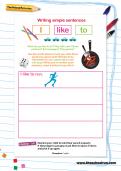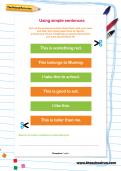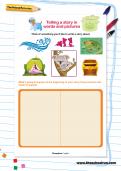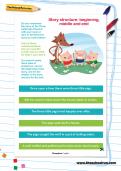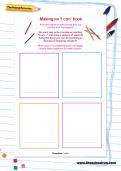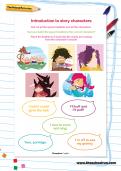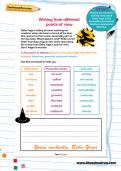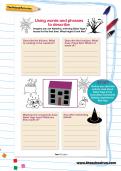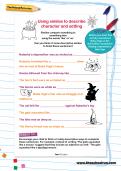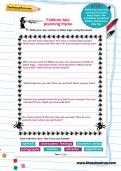Creative writing and fiction worksheets
Free worksheets: Creative writing and fiction, KS2
You’ll need to login or Register first to access these worksheets for free.
Once you’ve tried out our free worksheets, why not explore all our resources (1000s of worksheets, interactive tutorials, learning packs and more) with a 14-day FREE trial subscription.
Speech marks practice
Can you continue this conversation between Harry and Thenusha using the correct rules for reported speech? Remember to start each character’s speech on a new line. Use “ to open the speech. End the speech with !, ? or , and use ” to close the speech. Use a reporting clause (a verb like said, whispered or announced).
Writing an adventure story
You found a mysterious egg, then a weird and wonderful creature hatched from it and... Use your notes on the Using adjectives to improve writing and Word bank: powerful verbs worksheets to write your adventure story up neatly. Remember to include all your adjectives and verbs!
Planning and writing a story set in an imaginary world
Green or barren, deserted or populated by amazing creatures – it's time to enter an imaginary world! Your child will need to write a story set in an environment of their choosing, using the planning frame to help them organise their ideas before they put pen to paper.
Writing informative text
Have your child pretend they're helping out a new boy or girl who's just arrived at their school by explaining all of the important things they'd need to know, from homework to PE.
Using descriptive words
In this worksheet, your child can practise writing sentences with descriptive words, and understand why they are more interesting to read than sentences without descriptive words.
Writing an appeal
A poster is designed to find a volunteer to search for the goblin and his magical potion (from the story 'The goblin's curse'). What do you think it said? Include: an eye-catching title; a colourful picture; information about the problem and how it needs to be solved; adjectives to describe the type of person who needs to come forward; a reward.
Writing a formal letter
Read ‘The goblin’s curse’ first, then think about the letter that the king writes to the goblin asking for the healing potion. What would you have said in this vital letter? Don’t forget how to set out a letter correctly.
Expressing characters’ feelings
Once you've read the story of The Goblin's Curse, imagine that you are the goblin, having just met Orion and given him the potion. Explain your meeting and then describe how you capture forty years of the queen’s life in a bottle. How do you feel about it all?
Describing with adjectives
Can you draw the the goblin’s house from the story The Goblin's Curse? You don’t have to use the information given in the story, be as imaginative as you want! Label each picture with descriptions, including lots of good adjectives.
Understanding story maps
Using a story map framework will help you organise your ideas about the text in a clear and efficient way. Can you draw a story map with notes and pictures to show the structure of ‘The goblin’s curse’?
Summarising paragraphs
The author of ‘The stolen spy kit’ has split the story into eight paragraphs. Read through the story again and think about why the text has been split up this way. Can you write a phrase that sums up each paragraph in these boxes?
Powerful verbs in direct speech
Start by reading 'The stolen spy kit' then imagine that Matthew decides to tell his mum about the Spy Kit. What might he say to her? How do you think she would reply? Write the conversation they might
have. Remember the rules of speech!
have. Remember the rules of speech!
Describing events in a diary
This worksheet accompanies the reading comprehension: 'The stolen spy kit'. Imagine you are Matthew, writing a diary entry just after you have come home with the stolen spy kit. See if you can include longer sentences with two parts joined by a connective.
Completing a story map
Complete the reading comprehension: 'The stolen spy kit'. The see if you can draw a story map with notes and pictures to show the structure of the story.
Making a zig-zag book
Can you make some zig-zag books? First of all do a front cover for your story. Think about making it really exciting so that people want to read it. Also write your name on the front so that people know who wrote it. Then tell your story in the zig-zag book using words and pictures. You may even like to use speech bubbles!
Writing simple sentences
What do you like to do? Play with cars? Draw pictures? Eat sausages? Play games? Use the words above to help you write three sentences about what YOU like to do. Remember to use capital letters and full stops! When you’ve written each sentence, draw a picture to go with it.
Using simple sentences
Cut out the sentences below. Read them with your mum and dad, then sticky-tape them to objects around your house. Challenge an adult to find where you have placed them all!
Telling a story in words and pictures
Think of something you’d like to write a story about. What’s going to happen at the beginning of your story? Use pictures and words to explain.
Story structure: beginning, middle and end
Do you remember the story of the Three Little Pigs? Read it with your mum or dad, or tell them the story to remind them! Cut out these sentences below. Can you read the words? Ask an adult for help if you need it. You need to make three piles of sentences: one for the beginning of the story, one for the middle of the story and one for the end.
Making an ‘I can’ book
Ask your mum or dad to help you cut out the four rectangles. On each one write a sentence starting “I can…” and draw a picture of yourself doing the thing you can do (jumping or dancing or skipping, maybe?). When you’ve completed each rectangle staple them together to make a book.
Introduction to story characters
Cut out all the speech bubbles and all the characters. Can you match the speech bubble to the correct character? Place the bubble so it looks like the words are coming from the character’s mouth!
Writing from different points of view
Read the story about Baba Yaga then imagine what happens when Natasha first arrives at Baba Yaga's house. Write a brief letter from Baba Yaga to her sister, describing the events from Baba Yaga’s point of view. Don’t forget to include: A description of Natasha; details of how Baba Yaga feels about the intrusion; adjectives, powerful verbs and adverbs
Using words and phrases to describe
Read the story about Baba Yaga then imagine you are Natasha, entering Baba Yaga’s house for the first time. Can you answer these questions about how the house might look?
Using similes to describe character and setting
Similes compare something to something else using the words ‘like’ or ‘as’. Can you think of some descriptive similes to finish these sentences?
Folklore tale planning frame
Read the 'Baba Yaga' story then see if you can write your own version using the tips on this sheet to help. See if you can include powerful verbs, similes, adverbs and adjectives.
